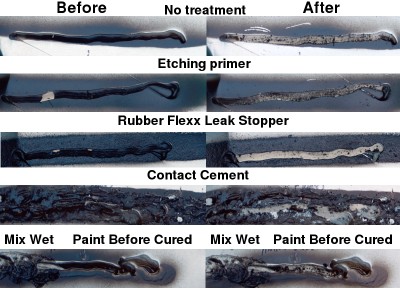 here are two main kinds of caulk: latex caulk and silicone caulk. Silicone caulk
is better: it adheres better to smooth surfaces and it lasts longer, and unlike
latex it comes out of the tube clear, which means you see what you get.
here are two main kinds of caulk: latex caulk and silicone caulk. Silicone caulk
is better: it adheres better to smooth surfaces and it lasts longer, and unlike
latex it comes out of the tube clear, which means you see what you get.
In my experience it also cures more reliably. Last weekend, I faced the unenviable task of scraping off some half-cured latex caulk on the flashing on my roof. It was two hours of tedious scraping with a piece of wood. But—and it's a big but (and no, I cannot lie, I do not like them!)—silicone cannot be painted. At least that's the dogma. But is it true?

Silicone caulk paint test results
To test this, I put some GE Silicone II caulk on a piece of aluminum, let it cure for 24 hours, then painted it in different ways using brown Rustoleum spray paint. After the paint dried, I tested how well it had stuck by trying to scrape it off. Here are the results.
In all cases, the paint went on smoothly and appeared to stick. It remained stuck after wiping with a paper towel or a dry finger. But it was easy to scrape off with a hard object like a fingernail, especially if the caulk was thick enough to be deformed while scraping. Rubber Flexx Leak Stopper and Dap Spray Contact Cement had no effect (Contact cement also created an unsightly mess). Etching primer and painting it before it cured helped slightly. Heating the painted caulk with a heat gun after it cured had no effect (not shown). Spraying the caulk while wet, then mixing it, worked well: the paint was inside, so it was impossible to scrape it off.
I haven't tried mixing the caulk with some other material like clay or sand or etching the caulk. Sanding it with 100 grit sandpaper or wiping it with a variety of lab chemicals including sodium hydroxide, acetone, toluene, hexane, hydrogen peroxide, chloroform, sodium hydroxide, acetic acid, or hydrochloric acid had no effect.
There are stronger chemicals that can produce surface modifications of silicone, but they wouldn't solve the main problem with silicone, which is its lack of rigidity.
Conclusion: If you paint silicone caulk after it cures, a thin layer of caulk will hold the paint a little better, and etching primer helps a little. But the best way to paint silicone caulk is to mix it with paint before it cures.
may 31, 2017; updated jun 03, 2017

